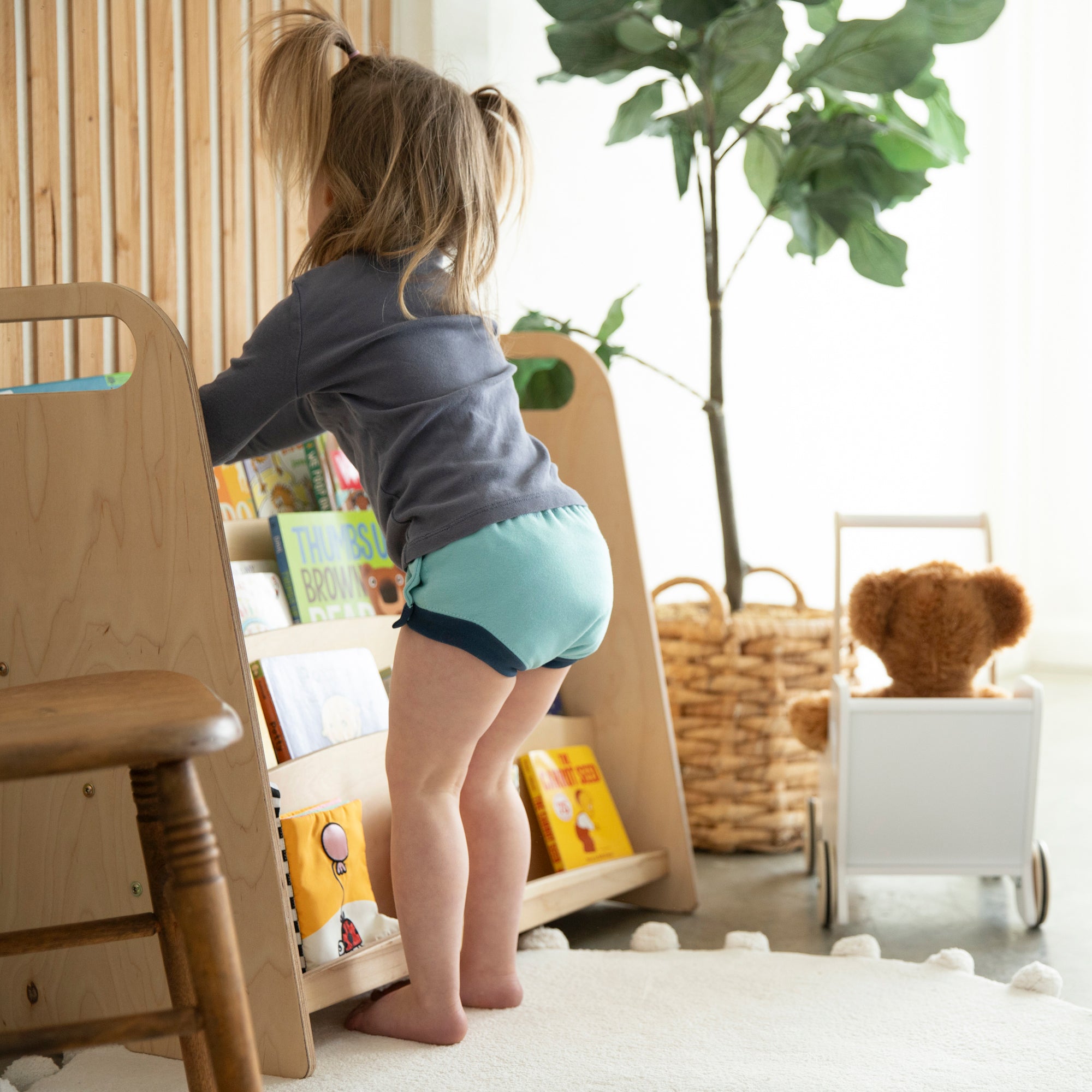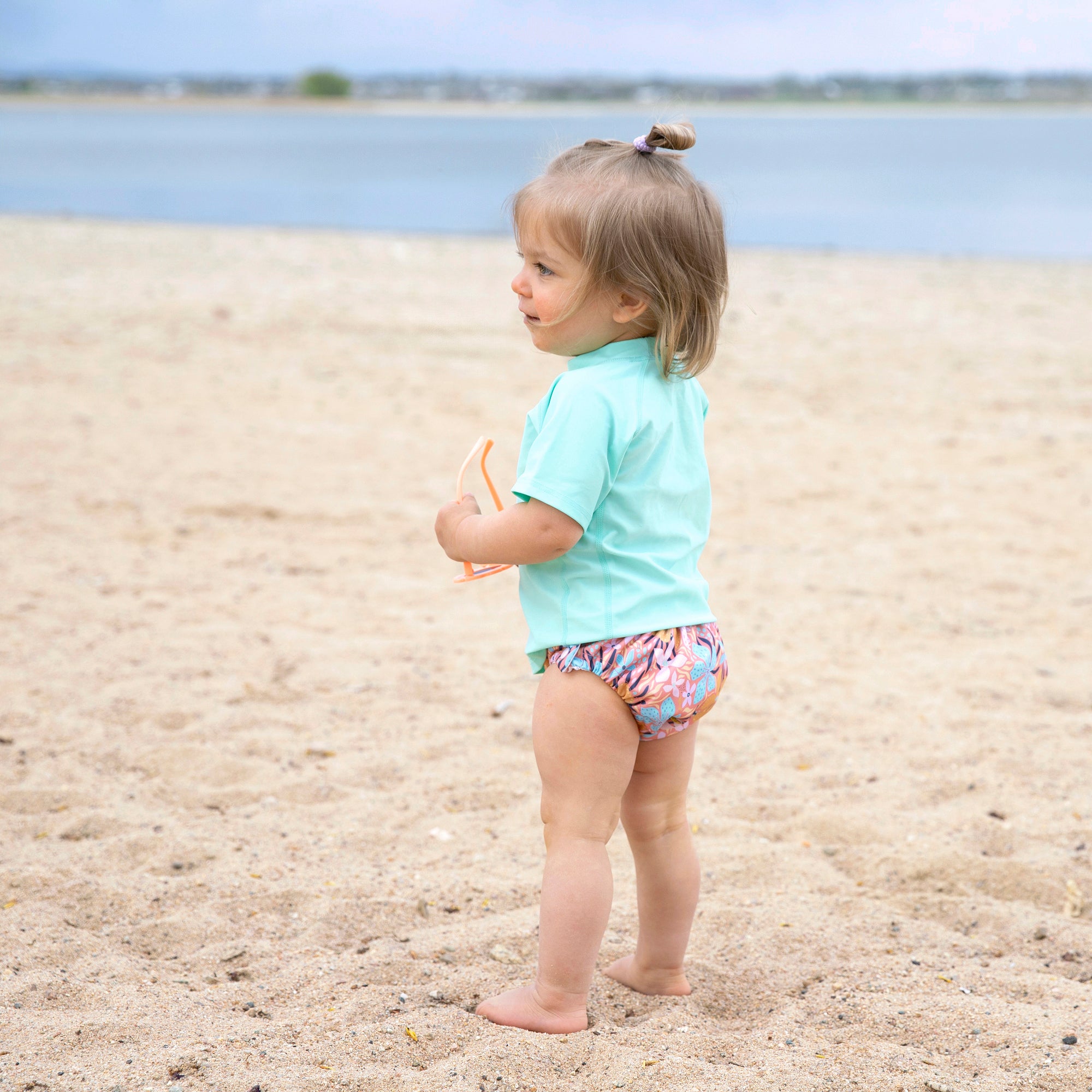Diaper rash is a skin irritation or "dermatitis" in the diaper area. You will most likely come across a diaper rash on your baby's skin at some point in their diapering years. Have no fear! Most cases disappear after home treatment.
Causes of diaper rash can be traced to a number of sources, including:
-
Irritation from feces and urine. Prolonged exposure to urine or feces can irritate a baby's sensitive skin. Your baby may be more prone to diaper rash if he or she is experiencing frequent bowel movements, because feces are more irritating than urine.
-
Introduction of new foods. As babies start to eat solid foods, the content of their stool changes, increasing the likelihood of diaper rash. Changes in your baby's diet can also increase the frequency of stools, which can lead to diaper rash. If you're breast-feeding, your baby may develop diaper rash in response to something you've eaten, such as tomato-based foods.
-
Irritation from a new product. Chemicals in disposable wipes, detergents, bleach, or fabric softener can irritate your baby's delicate bottom. Ingredients found in some baby lotions, powders and oils can also cause irritation.
-
Bacterial or yeast infection. What begins as a simple skin infection may spread to the surrounding region. The area covered by a diaper is especially vulnerable because it is warm and moist; making a perfect breeding ground for bacteria and yeast. These rashes generally start within the creases of the skin, and there may be red dots scattered around the creases.
-
Sensitive skin. Babies with skin conditions, such as atopic dermatitis or eczema, may be more likely to develop diaper rashes. However, the irritated skin of atopic dermatitis and eczema primarily affects areas other than the diaper area.
-
Chafing or rubbing. Tight-fitting diapers or clothing that rubs against the skin can lead to a rash.
-
Use of antibiotics. Antibiotics kill bacteria — both bad and good. Without the right balance of good bacteria, however, yeast infections can occur. This can happen when babies take antibiotics or when mothers who are breast-feeding their babies are taking antibiotics.
-
Teething – babies can develop diaper rash when teething. Teething can cause extra ammonia in the system, which in turn will "burn" the skin causing a very painful diaper rash.
-
Diapers that are not thoroughly cleaned – Cloth diapers can harbor bacteria – especially in very thick diapers that are hard to deep clean. A thorough cleaning with a safe and effective detergent is essential. For Laundering tips, please go to our website at: http://www.thirstiesbaby.com/customer-center/care-use/.
IDENTIFYING SPECIFIC DIAPER RASHES Here are a few diaper rashes that can be more than just irritation from the stool, urine, and diaper. They usually require more specific therapy:
Contact diaper rash - this is simply the regular rash as discussed above. Appearance - flat, red, irritated skin. When severe, skin will peel or blister and slough off. Treatment – a cloth diaper safe cream.
Intertrigo - this is a specific rash that occurs within the skin folds and creases around the diaper area where the skin rubs together. Appearance - Heat and moisture mixed with urine cause a red, burn-like appearance. Treatment – a cloth diaper safe cream.
Yeast rash - when the skin is damaged, yeast from the intestines can invade the skin. This especially occurs with antibiotic use or prolonged rash. Appearance - it is a red, raised, patchy rash with sharp borders, mostly over the genitalia but with satellite spots sprinkled around the diaper area. Treatment - in addition to the above measures, there are two commonly used anti-fungal creams:
- Clotrimazole - over-the-counter. Apply 2 - 3 times a day beneath another cream.
- Nystatin - prescription. Not necessarily better, just different.
- Acidophilus - this is a natural bacterial powder that fights off yeast.
Impetigo - this occurs when bacteria invade the damaged skin. Appearance - coin-sized blisters or red raised patches that ooze a honey-colored crust. Treatment - prescription antibiotic ointment as well as the above general measures. *Be careful when using ointments with cloth diapers. If you do use ointments, you might need to strip the diapers each time they are washed to avoid diaper leaks and stink issues. Diaper stripping is only recommended when needed.
Seborrhea - an inflammatory condition that can affect different parts of the body, but can be especially severe in the diaper area. Appearance - a big, red, sharply demarcated patch over the groin, genitalia, and lower abdomen. It can be more raised, rough, thick, and greasy than the other rashes. Treatment – a cloth diaper safe diaper cream.
Allergy ring - a variety of foods can irritate baby's bottom, especially acidic foods such as citrus and tomato-based sauces. Appearance - a red ring around baby's anus. Treatment - discontinue suspected foods. Breastfeeding moms may need to eliminate certain foods from their diet.
When to seek medical advice Diaper rash is usually easily treated and improves within several days after starting home treatment. If your baby's skin doesn't improve after a few days of home treatment with over-the-counter ointment and more frequent diaper changes,
talk to your doctor. Sometimes, diaper rash leads to secondary infections that may require prescription medications. Have your child examined if the rash is severe, worsens despite home treatment or occurs along with any of the following:
- Fever
- Blisters or boils
- A rash that extends beyond the diaper area
- Pus or weeping discharge
Prevention:
-
Rinse your baby's bottom with water as part of each diaper change. You can use cloth wipes with a mild wipes solution, or fresh water. Do not allow plain water to sit for diaper changes as it can be a breeding ground for bacteria. Don't use wipes that contain alcohol or fragrance.
-
Pat your baby dry with a clean towel. Don't scrub your baby's bottom. Scrubbing can further irritate the skin.
-
Give your baby's bottom a little breathing room. When possible, let your baby go without a diaper. Exposing skin to air is a natural and gentle way to let it dry. To avoid messy accidents, try laying your baby on a large towel and engage in some playtime while he or she is bare-bottomed.
-
Don't over-tighten diapers. Diapers that are too tight prevent airflow into the diaper region, setting up a moist environment favorable to diaper rashes. Tight fitting diapers can also cause chafing at the waist or thighs.
-
Change diapers often. Remove dirty diapers promptly. If your child is in child care, ask staff members to do the same.
-
After changing diapers, wash your hands well. Hand washing can prevent the spread of bacteria or yeast to other parts of your baby's body, to you or to other children.
-
Wash cloth diapers carefully. Prewash in cold, and wash on Hot. Use a cloth diaper safe detergent and skip the fabric softeners and dryer sheets because they can contain fragrances that may irritate your baby's skin. Other ingredients to avoid are soap, enzymes, brighteners, bleach, dyes, and perfumes. Double rinse your baby's diapers if your child already has a diaper rash or is prone to developing diaper rash.
Remedies: Over-the-counter products: Various diaper rash medications are available without a prescription. Zinc oxide is the active ingredient in many diaper rash creams, but should not be used with cloth diapers as it coats the diapers causing stink and repelling issues. Lanolin is great for breast-feeding mothers, but straight Lanolin is not recommended - it is just about impossible to wash out of microfiber cloth diapers! We recommend any 4 star cream from
www.pinstripesandpolkadots.com/diaperrashcreams.htm.
Increasing airflow: To aid the healing of diaper rash, do what you can to increase airflow to the diaper region. These simple suggestions may help:
- Let your child go without a diaper for short periods of time.
- Avoid using tight-fitting diaper covers.
- Use larger sized diapers until the rash goes away.
While your baby has a diaper rash, avoid washing the affected area with soaps and disposable, scented wipes. Alcohol and perfumes in these products can irritate your baby's skin and aggravate or prolong the rash. A good choice is to use cloth wipes such as
Thirsties Organic Cotton Wipes. They are soft and gentle on baby's skin, and best for baby as well as the environment. In the past, it was common to use talcum powder to protect a baby's skin and absorb excess moisture. However, doctors no longer recommend this. Inhaled talcum powder can irritate a baby's lungs. Resources for this information include the Mayo Clinic Online, Ask Dr. Sears Online, and Thirsties, Inc.
**Important note: Before diagnosing or treating a rash we do recommend consulting with your pediatrician at all times. *This post originally posted on June 22nd, 2011.







My son has a rash and I am so scared because it is associated with very high fever. I hope its not roseola infantum
Thank you! Great info for a new mama, forwarding to my newly cloth diapering friend!
Wow, thank you for this fantastic post! I needed this right now!
Great reference.
My LO has had some redness for the last few days. I’ve been using a cloth diaper safe cream, but no luck yet getting it to go away. I am going to try using a larger sized diaper cover for the next few days.
Hannah
Great post. Definitely bookmarking for later.
You're viewing 1-5 of 14 comments